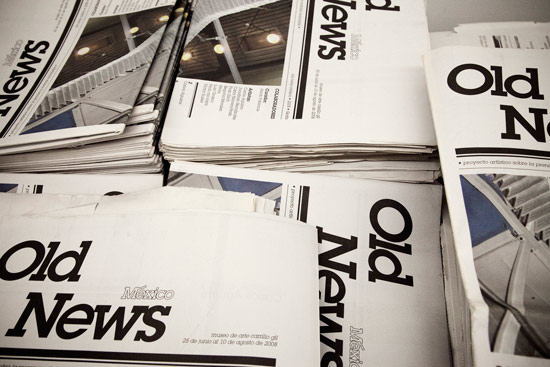The New Museum’s latest exhibition “The Last Newspaper” is without a doubt the most impressive thing I have seen at the Museum since it opened its doors on the Bowery.
As the title suggests, the exhibition is a 3-floor reflection upon the various ways in which artists are influenced by and respond to news media. Through a semi historic display unfamiliar to the walls of this museum we shift between mixed media works by artists such as Alighieri e Boetti and Judith Bernstein. These are great heavy looking collages which make obvious and forceful use of newsprint. Also of particular interest is “News” by Hans Haacke in which stories from 35 different RSS feeds are beamed directly to a printer installed on a table in the middle of one gallery. Originally conceived in 1969, the imposing knot of information is a metaphor made more poignant by the digital age in which we live. A series of works by Dash Snow serve as a bold commentary on the tabloid coverage of Saddam Hussein’s trial and subsequent execution.
I was impressed by the exhibition’s conceptual narrative which explores the dual functionality of news media as both a source of content and vehicle for its delivery. This is not merely an art exhibit inspired by the news media. A broad sheet from Dexter Sinister’s project The Last Newspaper on display in the exhibition’s first gallery, is one example of how artists use the news as a vehicle for art. For his project the artist worked with a team of copywriters and editors turning a storefront in the Port Authority Bus Terminal into a newsroom for one week. Each day his team turned out a one-page broadside reflecting the nature of the news in today’s society.
Rather than depicting the typical New Museum fashion, curators have invited a group of partner organizations to use their gallery space as an ad hoc creative newsroom. A weekly publication, conceived within the exhibition space will form a sort of de facto museum catalogue. I applaud the curators’ efforts to create an inclusive, didactic environment; however, certain participant organizations would have been better off excluded. The inclusion of the Center for Urban Pedagogy’s exhibit aimed at instructing audiences about zoning laws, seemed gratuitous. A set of customizable office furniture by C Lab felt a bit too reminiscent of a please touch museum. While the show was an overall success, I wish the museum’s curators would slow down in their race for “New Art” and “New Ideas,” lest they trip over themselves.
Images by Jenna Duffy








 RSS
RSS
